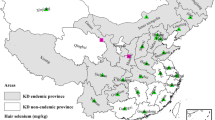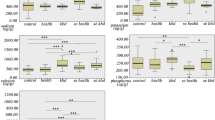Abstract
Previous studies have shown that the selenium (Se) deficiency is an important factor for the etiology of Kashin–Beck disease (KBD). Although KBD is presently controlled in most regions of China, it is still active in the Tibetan Plateau. The present study aimed to assess the nutritional status of selenium in school children by using the Se level in hair as a biomarker in KBD endemic areas of Lhasa in Tibet, China. Hair samples of 155 school children aged 6–15 years were collected in both KBD areas and non-KBD areas of Lhasa in 2013. The Se level in the hair samples was determined by inductive coupled plasma mass spectrometry (ICP-MS). The average concentration of Se in children’s hair was 0.232 μg/g in KBD areas of Lhasa, which was significantly higher than the data reported decades ago. A significant difference in hair Se was observed between the boys (0.255 μg/g) and the girls (0.222 μg/g) in the studied KBD areas (P < 0.01, Mann–Whitney U test), but hair Se did not vary by age or region. School children in KBD endemic areas in Lhasa likely have improved Se status as a result of high Se content staple food substitution with the enforcement of Free Education Policy and Nutrition Improvement Plan in Tibet. Nevertheless, there were still 20.3 % of students with low Se status (hair Se <0.20 μg/g), which showed that Se status of school children was also partly affected by low Se environment in KBD endemic areas of Lhasa.


Similar content being viewed by others
References
Tan J (1989) The Atlas of Endemic Diseases and their Environments in the People’s Republic of China. Science Press, Beijing, In Chinese
Zhao Z, Li Q, Yang P et al (2013) Selenium: a protective factor for Kashin–Beck disease in Qing-Tibet plateau. Biol Trace Elem Res 153:1–4
The Ministry of Health Statistics Information Center. China health development of statistical bulletin in 2006. http://www.moh.gov.cn/newshtml/18903.htm1988.
Fang HC (1988) The relationship of Kashin-Beck and Keshan diseases with hydrogeochemistry. Environ Geo Water Sci 12:23–28
Zamana LV (1995) Possible hydro-geochemical preconditions for Kashin-Beck disease in Transbaikalia. Chinese Geograph Sci 5:185–192
Chasseur C, Suetens C, Nolard N et al (1997) Fungal contamination in barley and Kashin-Beck disease in Tibet. Lancet 350:1074
La GM, Mathieu F, Begaux F et al (2001) Kashin-Beck disease and drinking water in central Tibet. Int Orthop 25:167–169
Chasseur C, Suetens C, Michel V et al (2001) A 4-year study of the mycological aspects of Kashin-Beck disease in Tibet. Int Orthop 25:154–158
Tan J, Wang W, Zhu Z et al (1988) Selenium in environment and Kashin-Beck disease. Chin J Geochem 7:273–280
Yang J (1995) Etiology of Kashin–Beck disease. China J Endemiol 14:201–204 (In Chinese)
Peng A, Wang W, Wang C et al (1999) The role of humic substances in drinking water in Kashin–Beck disease in China. Environ Health Persp 107:293–296
Suetens C, Moreno-Reyes R, Chasseur C et al (2001) Epidemiological support for a multi-factorial etiology of Kashin–Beck disease in Tibet. Int Orthop 25:180–187
Guo X (2008) Progression and prospect of etiology and pathogenesis of Kashin-Beck disease. J Xian Jiaotong Univ (Medical Sciences) 29:481–488 (In Chinese)
Li C (1979) Observation on the efficiency of the cure KBD in 224 cases with selenium and vitamin E, and a discussion on the etiology of KBD. Chin Med J 59:169–171 (In Chinese)
Peng A, Yang C (1991) Examination of the roles of selenium in the Kashin-Beck disease. Biol Trace Elem Res 28:1–9
Xu L, Sen W, Xiong Q et al (1991) Selenium in Kashin-Beck disease areas. Biol Trace Elem Res 31:1–9
Tan J, Zhu W, Wang W et al (2002) Selenium in soil and endemic diseases in China. Sci Total Environ 28:227–235
Moreno-Reyes R, Mathieu F, Boelaert M et al (2003) Selenium and iodine supplementation of rural Tibetan children affected by Kashin–Beck osteoarthropathy. Am J Clin Nutr 78:137–144
Canter PH, Wider B, Ernst E (2007) The antioxidant vitamins A, C, E and selenium in the treatment of arthritis: a systematic review of randomized clinical trials. Rheumatology 46:1223–1233
Wang W, Wang M, Zhu Z et al (1985) Geographic epidemiological research on Keshan Disease, Kashin-Beck Diseases in Tibet. Proceedings of the second chemical geography conference of China. Science Press, Beijing, pp 85–91, In Chinese
Gong H, Zhaxi S, Xirao R et al (2004) Sampling monitoring report on the prevalence condition of Kashin-Beck Disease in Tibet. China J Endemiol 23:91 (In Chinese)
Institute of Kashin-Beck disease in Center for endemic disease control of China (2000). Investigative report on the prevalence condition of Kashin-Beck Disease (KBD) in Tibet China J Endemiol 19:41–43 (In Chinese)
Li S, Li W, Hu X et al (2009) Soil selenium concentration and Kashin-Beck disease prevalence in Tibet. China Front Environ Sci Engin China 3:62–68
Zhang B, Yang L, Wang W et al (2011) Environmental selenium in the Kashin-Beck disease area, Tibetan Plateau, China. Environ Geochem Health 33:495–501
Gong H, Zhaxi D, Xirao R et al (2004) Kashin-Beck disease sampling test report in Tibet. China J Endemiol 23:91 (In Chinese)
Zhang H (2011) Children of farmers, herdsmen to enjoy free education in Tibet. People’s Daily Online. http://english.peopledaily.com.cn/90001/90776/90882/7285747.html
Da Cunha S, Filho FM, Antelo DS et al (2003) Serum sample levels of selenium and copper in healthy volunteers living in Rio deJaneiro city. Sci Total Environ 301:51–54
Li N, Gao Z, Luo D et al (2007) Selenium level in the environment and the population of Zhoukoudian area, Beijing, China. Sci Total Environ 381:105–111
Golub Kina NA, Alffhan GV (1999) The Human Selenium Status in 27 Regions of Russia. J Trace Elements Med Bio 13:15–20
Navarro-Alarcon M, Cabrera-Vique C (2008) Selenium in food and the human body: a review. Sci Total Environ 400:115–141
Piccinini L, Borella P, Bargellini A et al (1996) A case–control study on selenium, zinc, and copper in plasma and hair of subjects affected by breast and lung cancer. Biol Trace Elem Res 51:23–30
Borella P, Bargellini A, Caselgrandi E et al (1997) Observations on the use of plasma, hair and tissue to evaluate trace element status in cancer. J Trace Elem Med Biol 11:162–165
Chen X, Yang G, Chen J et al (1980) Studies on the relations of selenium and keshan disease. Biol Trac Elem Res 2:91–107
Mengüba K, Gökmen CI, Diab N et al (1992) Selenium status of normal Turkish children. Biol Trace Elem Res 133:160
Dong Z, Bank MS, Spengler JD (2015) Assessing metal exposures in a community near a cement plant in the Northeast U.S. Int J Environ Res Public Health 19:952–969
Ashton K, Hooper L, Harvey LJ et al (2009) Methods of assessment of selenium status in humans: a systematic review. Am J Clin Nutr 89:2025S–2039S
Musa-Alzubaidi LI, Kasperek K et al (1982) Hair selenium content during infancy and childhood. Eur J Pediatr 139:295–296
Viju V, Thomas RK, Haswell SJ et al (2013) Maternal hair selenium levels as a possible long-term nutritional indicator of recurrent pregnancy loss. BMC Womens Health 13:40
Ministry of Health of the People’s Republic of China (2010) Diagnosis of Kashin-Beck Disease (WS/T207–2010)
Gao J, Liu Y, Huang Y et al (2011) Daily selenium intake in a moderate selenium deficiency area of Suzhou, China. Food Chem 126:1088–1093
Keshavarzi B, Moore F, Najmeddin A et al (2012) The role of selenium and selected trace elements in the etiology of esophageal cancer in high risk Golestan province of Iran. Sci Total Environ 433:89–97
Forrer R, Gautschi K, Stroh A et al (1999) Direct determination of selenium and other trace elements in serum samples by ICP-MS. J Trace Elem Med Biol 12:240–247
Labat L, Dehon B, Lhermitte M (2003) Rapid and simple determination of selenium in blood serum by inductively coupled plasma-mass spectrometry (ICP-MS). Anal Bioanal Chem 376:270–273
Zaitseva IP, Skalny AA, Tinkov AA et al (2015) The influence of physical activity on hair toxic and essential trace element content in male and female students. Biol Trace Elem Res 163:58–66
Kang F, Li Y, Wei J et al (2013) Analysis of selenium concentration in hair samples of children in Kashin Beck Disease areas in Gansu Province. China J Endemiol 32:556–560 (In Chinese)
Xu S, Zhang X, Lv H et al (2013) Selenium levels inside and outside environment of Jinlin Province Kashin-Beck Disease area. China J Ctrl Endemiol Dis 28:340–342 (In Chinese)
Centers for Disease Control and Prevention (2008) Trace elements: selenium. In: National report on biochemical indicators of diet and nutrition in the US population 1999–2002. pp101–106. http://www.cdc.gov/nutritionreport/99–02/part_4b.html
Brtková A, Magálová T, Béderová A et al (1999) Serum selenium levels in healthy Slovak children and adolescents. Biol Trace Elem Res 67:49–54
Thomson CD, McLachlan SK, Parnell WR et al (2007) Serum selenium concentrations and dietary selenium intake of New Zealand children aged 5–14 years. Br J Nutr 97:357–364
Pan D, Huang H (2013) Hair selenium levels in hepatic steatosis patients. Biol Trace Elem Res 152:305–309
Li S, Bañuelos GS et al (2014) The changing selenium nutritional status of Chinese residents. Nutrients 6:103–1114
Clark NA, Teschke K, Rideout K et al (2007) Trace element levels in adults from the west coast of Canada and associations with age, gender, diet, activities, and levels of other trace elements. Chemosphere 70:155–164
Xu X, Gao Q, Chen Y et al (2012) Study on the selenium nutrition of children in Kashin-Beck disease endemic areas in Rang tang county, Sichuan province. J China West Normal Univ (Natural Sciences) 33:79–82 (In Chinese)
Zhang Q, Wang H, He D et al (2011) Selenium levels inside and outside Qinghai Province Kashin-Beck disease district environment from 2007 to 2009. China J Endemiol 26:119–121 (In Chinese)
Wang D, Yang W, Sun Q et al (1987) Study on the etiology of Kashin Beck disease areas of Henan province and the relationship between environmental and human selenium. China J Endemiol 6(2):108–111 (In Chinese)
Gao G, Zhang J, Si Y et al (2004) Investigation of hair selenium levels of preschool children in Xinxiang districts. J Appl Clin Pediatr 19:609–610 (In Chinese)
Tan J (1990) Chemico-geography of some life elements and endemic diseases with an emphasis on China. Environmental life elements and health. Science Press, Beijing, pp 145–157
Lv Y, Yu T, Zhao W et al (2014) Constraint on selenium bioavailability caused by its geochemical behavior in typical Kashin–Beck disease areas in Aba, Sichuan Province of China. Sci Total Environ 493:737–749
Li S, Xiao T, Zheng B (2012) Medical geology of arsenic, selenium and thallium in China. Sci Total Environ 421–422:31–40
Hou S, Zhu W (1982) Study on the hair selenium concentration and its background value in different natural environment of China. Environ Sci 2:29–35 (In Chinese)
Zhaxi S, Gong H, Gesang D et al (2003) Selenium test results analysis in Tibet Kashin Beck Disease areas. China J Ctrl Endem Dis 18:177 (In Chinese)
Morris YC et al (1970) Selenium contents of foods. J Nutrit 100:1383–1388
Klapec T, Mandic ML, Grgic J et al (2004) Selenium in selected foods grown or purchased in eastern Croatia. Food Chem 85:445–452
Sirichakwal PP, Puwastein P, Polngam J et al (2005) Selenium content of Thai foods. J Food Compos Anal 18:47–59
Pappa EC, Pappas AC, Surai PF (2006) Selenium content in selected foods from the Greek market and estimation of the daily intake. Sci Total Environ 372:100–108
Acknowledgments
We gratefully acknowledge funding from the National 12th Five-Year Plan scientific and technological issues (No. 2013BAC04B03) and the National Natural Science Foundation of China (No. 41171081). We also thank the local government of Tibet Centers for Disease Control and Prevention and Lhasa Centers for Disease Control and Prevention, Tibet Autonomous Region for their help during the field investigations and sampling, which were carried out in August 2013. The editor and two anonymous reviewers are thanked for their helpful comments on the manuscript to improve the quality of the paper.
Author information
Authors and Affiliations
Corresponding author
Rights and permissions
About this article
Cite this article
Chen, Z., Li, H., Yang, L. et al. Hair Selenium Levels of School Children in Kashin–Beck Disease Endemic Areas in Tibet, China. Biol Trace Elem Res 168, 25–32 (2015). https://doi.org/10.1007/s12011-015-0333-4
Received:
Accepted:
Published:
Issue Date:
DOI: https://doi.org/10.1007/s12011-015-0333-4




